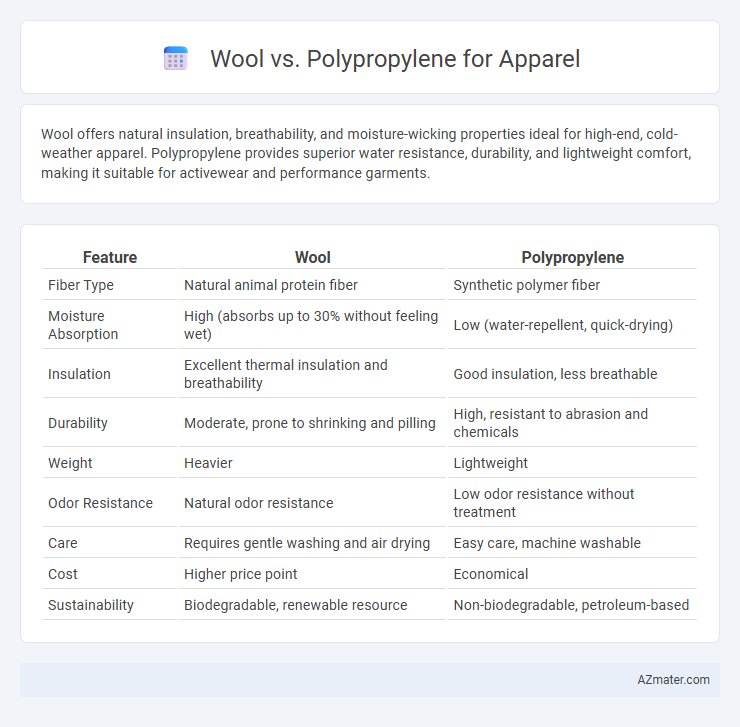Wool offers natural insulation, breathability, and moisture-wicking properties ideal for high-end, cold-weather apparel. Polypropylene provides superior water resistance, durability, and lightweight comfort, making it suitable for activewear and performance garments.
Table of Comparison
| Feature | Wool | Polypropylene |
|---|---|---|
| Fiber Type | Natural animal protein fiber | Synthetic polymer fiber |
| Moisture Absorption | High (absorbs up to 30% without feeling wet) | Low (water-repellent, quick-drying) |
| Insulation | Excellent thermal insulation and breathability | Good insulation, less breathable |
| Durability | Moderate, prone to shrinking and pilling | High, resistant to abrasion and chemicals |
| Weight | Heavier | Lightweight |
| Odor Resistance | Natural odor resistance | Low odor resistance without treatment |
| Care | Requires gentle washing and air drying | Easy care, machine washable |
| Cost | Higher price point | Economical |
| Sustainability | Biodegradable, renewable resource | Non-biodegradable, petroleum-based |
Introduction to Wool and Polypropylene in Apparel
Wool is a natural fiber known for its excellent insulation, moisture-wicking properties, and breathability, making it ideal for cold-weather apparel. Polypropylene, a synthetic polymer, is lightweight, highly water-resistant, and offers strong thermal retention, often used in performance wear and base layers. Both materials serve distinct functions in apparel, with wool providing natural comfort and polypropylene excelling in durability and moisture management.
Source and Production Methods
Wool is a natural fiber derived from the fleece of sheep, harvested through shearing and processed by cleaning, carding, and spinning to produce yarn. Polypropylene, a synthetic fiber, is produced through polymerization of propylene monomers derived from petroleum, followed by melt spinning to create fibers. The renewable, biodegradable nature of wool contrasts with polypropylene's petrochemical origin and energy-intensive manufacturing process.
Comfort and Softness Compared
Wool offers superior natural breathability and moisture-wicking properties, making it exceptionally comfortable and soft against the skin for extended wear. Polypropylene, while lightweight and moisture-resistant, tends to trap heat and can feel less breathable, potentially causing discomfort during prolonged use. Wool's fibers provide a plush, insulating texture that outperforms the synthetic feel of polypropylene in terms of overall softness and comfort in apparel.
Moisture Management and Breathability
Wool offers superior moisture management by naturally wicking sweat away from the skin and retaining warmth even when damp, making it ideal for activewear in cold conditions. Polypropylene excels in moisture resistance and quick-drying properties, preventing water absorption and maintaining dryness during intense workouts. Wool provides better breathability through its natural fiber structure, while polypropylene relies on synthetic design to enhance airflow and moisture evaporation.
Insulation and Thermal Performance
Wool provides superior insulation and thermal regulation due to its natural crimped fibers, which trap air and retain heat even when wet. Polypropylene excels in moisture-wicking and quick-drying properties, maintaining warmth by preventing sweat from chilling the skin. For cold-weather apparel, wool offers better warmth retention, while polypropylene is ideal for active wear requiring both insulation and moisture management.
Durability and Longevity
Wool offers natural resilience with excellent elasticity, which helps garments maintain shape and resist wear over time, providing long-lasting durability. Polypropylene, a synthetic fiber, excels in moisture-wicking and abrasion resistance, making it suitable for high-performance apparel that endures repeated use and harsh conditions. Choosing between wool and polypropylene depends on the specific durability needs, with wool preferred for natural longevity and polypropylene favored for robust synthetic endurance.
Weight and Fabric Feel
Wool fabric is naturally lightweight and breathable, offering excellent insulation without feeling heavy, making it ideal for comfortable apparel in varying temperatures. Polypropylene fabric is even lighter than wool and has a smooth, synthetic feel that wicks moisture efficiently but may lack the natural softness and warmth of wool. The choice between wool and polypropylene depends on the desired balance between natural texture, weight, moisture management, and thermal regulation in clothing.
Environmental Impact and Sustainability
Wool is a natural, biodegradable fiber with a renewable production cycle, emitting fewer greenhouse gases compared to synthetic alternatives. Polypropylene, a petroleum-based plastic, contributes significantly to carbon emissions and persists in the environment due to its non-biodegradable nature. Choosing wool over polypropylene in apparel reduces microplastic pollution and supports sustainable land use practices.
Cost and Value Considerations
Wool typically costs more than polypropylene due to its natural origin, durability, and superior insulation properties, offering long-term value through enhanced comfort and breathability. Polypropylene, being a synthetic fiber, is generally more affordable and provides excellent moisture-wicking and quick-drying features, making it cost-effective for activewear and budget-conscious consumers. When considering value, wool's premium price aligns with its longevity and temperature regulation, while polypropylene offers practical, low-cost performance suitable for high-intensity and frequently washed apparel.
Best Uses: Choosing the Right Fiber for Your Needs
Wool excels in insulation, moisture-wicking, and breathability, making it ideal for cold-weather apparel, outdoor activities, and performance layering. Polypropylene offers excellent water resistance, quick drying, and lightweight durability, perfect for activewear, base layers, and moisture management during high-intensity workouts. Selecting wool or polypropylene depends on prioritizing warmth, odor resistance, and natural fibers versus synthetic durability and moisture control in apparel design.

Infographic: Wool vs Polypropylene for Apparel
 azmater.com
azmater.com